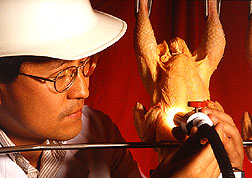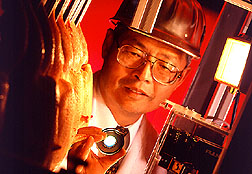Automated Chicken Inspection
As chickens move down the processing line at speeds as high as 140 birds per minute, four cameras click away, followed by near-infrared and visible light scans of each bird.
Instantly, a computer decides whether a chicken has signs of defects or disease. If not, the bird continues down the production line. Otherwise, the computer directs the suspect carcass to a separate re-inspect line.
On the re-inspect line, birds get a closer examination by a human inspector because the automated system spotted signs--such as reddish or purplish skin or abnormally small body size--that suggested unwholesomeness.
That's the chicken plant of the near future, says Yud-Ren Chen, an agricultural engineer with the Agricultural Research Servicewho has led the group that designed and built the prototype. He says the increasing popularity of poultry products has made improved inspection even more important.
Chen's group will test their prototype this year at Tyson Food's poultry processing plant in New Holland, Pennsylvania.
"Almost 8 billion chickens go through federally inspected plants annually, compared to less than 3 billion 30 years ago," Chen says. "If you are going to increase productivity without sacrificing the accuracy of meat and poultry inspection, you have to use machine vision and other automated sensors."
Developed over the past 7 years, the prototype consists of four spectral cameras, a light probe, and a spectrophotometer--all linked to computers. When the chickens, on hooks dangling from a moving chain, pass through a light beam, the interruption triggers a fraction-of-a-second photo opportunity: One pair of cameras takes photos of the chicken's front; the other pair, its back. One camera of each pair uses a red filter; the other, a green one. This obtains images of the bird's front and back in two colors.
"The same physical condition--involving surface color and texture--shows up differently under different wavelength filters," says Chen. "We use two wavelengths for comparison, to be sure we don't miss anything."
|
|
Chen's group developed computer software that compares the images at different wavelengths, to determine if the bird is wholesome or not. Color differences can be caused by improper bleeding during slaughter or by blood-related diseases like septicemia. Skin textural differences can be caused by tears, bruises, or tumors.
The cameras also detect body size. Chen explains that an abnormally small chicken requires closer inspection because disease may have stunted the bird's growth.
After a chicken passes the cameras, it crosses another light beam, this one triggering a scan from about an inch away.
A light probe illuminates a portion of the chicken with both near-infrared and visible light. The chicken absorbs some of the light, but any that is reflected is analyzed by the spectrophotometer and computer using software developed by Chen's team.
Differences between light shining on the bird and light reflection are due to variations in external skin color and texture and to internal blood color and tissue composition. In the prototype, the probe can analyze properties deep beneath the chicken's skin, stopping only at the abdominal cavity.
A red light on the frame near the computer setup indicates rejection.
"The computer can also keep a record of the conditions of each bird on the line, ready for the inspector's review," Chen says.
Chen's group has tested the system in a chicken plant in West Virginia. All those tests used birds hung on a portable conveyor line brought to the plant--alongside, but not on, a real production line like the one at the Tyson's New Holland plant.
Leonard Payne, who manages the New Holland plant, has been looking forward to this first production-line test of Chen's automated system.
Payne says machine vision would benefit the industry mainly through more consistency and accuracy. In most cases, wholesome birds differ obviously from unwholesome ones.
"Over 90 percent of the birds are unquestionably wholesome. Machine vision could quickly pass these birds on, while identifying those that require a second look to determine if a problem exists," says Payne.
"The federal inspectors and the assistants we provide are highly trained. But machine vision can free them to focus on the relatively few birds whose condition is not conclusive," he says. Payne sees machine vision, if it works as expected, as a win-win situation for consumers, inspectors, and the industry.
For Chen, an important part of the Tyson's test is to see how the system stands up to the high humidity of a commer
cial production plant.
"We want to see how long the prototype lasts in this environment, how much maintenance it'll need, and how accurate and consistent it is online," says Chen. "The prototype has an average accuracy rate of over 95 percent. We are continually improving this, and we achieved 100 percent accuracy in a recent test comparing the system's conclusions with those of a veterinarian."
"To maintain accuracy," he says, "the system occasionally needs retraining with special software. This adjusts the computer to recognize the normal skin color of different chicken breeds or chickens fed different rations, for example. Processing plant employees would do this retraining by running self-learning software while flipping switches to show the system chickens that are normal and chickens that are not."
Though this prototype can spot unwholesome birds, it can tell the reasons for condemnation only in cases of septicemia or improper bleeding. "But," notes Chen, "these two conditions account for over half of the carcasses removed from the processing lines."
Chen aims to expand the system's capabilities, along with incorporating advances in computer and sensor technology. He is also planning to test a new probe that will explore the whole chicken--still without touching it--and take color photographs of the abdominal cavity as well as the viscera. The color images would also be analyzed by the computer.
Ultimately, Chen wants the automated system to quickly diagnose every physical or biological condition that causes an inspector to remove chickens from the processing line. It cannot spot bacterial contamination, he explains, adding that many other scientists are busy developing tests for that.--By Don Comis, Agricultural Research Service Information Staff, 6303 Ivy Lane, Greenbelt, Maryland 20770, phone (301) 344-2748.
Yud-Ren Chen is at the USDA-ARS Instrumentation and Sensing Laboratory, 10300 Baltimore Ave., Beltsville, MD 20705-2350; phone (301) 504-8450, fax (301) 504-9466, e-mail
"Automated Chicken Inspection" was published in the May 1998 issue of Agricultural Research magazine. Click here to see this issue's table of contents.









